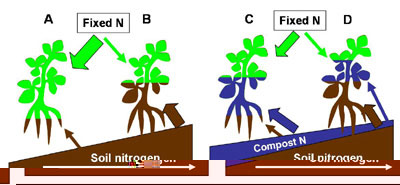Legume nitrogen fixation learning module
The effects of soil fertility on legume N fixation
The soil environment affects legume N fixation through direct and indirect effects on the plants and bacteria involved in N fixation. Plants decrease their investment in nodules if sufficient soil N is available because supporting N-fixing bacteria and nodules is a costly proposition for the plant. Other soil environmental conditions also influence legume N fixation, including soil texture, soil moisture, phosphorus availability and soil pH.
In organic farming systems, legume N fixation rates are influenced by management practices such as compost additions and rotations which tend to gradually build soil organic matter and increase soil N fertility over time (Figure 1). This is a useful internal feedback which can actually help organic systems to maintain a healthy nutrient balance over the long term. However, at this point, we do not have sufficient information to make specific recommendations about how to optimize N fixation in organic systems. Since most organic farmers use compost and other organic amendments in conjunction with legumes, it will be important for us to improve our understanding of how these fertility sources interact with N fixation. To read about how we are conducting research to study this question, see the N fixation research module.

Larger image
Figure 1. Interaction of soil nitrogen and legume N fixation. As soil N availability increases with increasing soil organic matter, legume N fixation decreases because the plant is able to take up more N from the soil. Plant A is dependent on N fixation to a greater degree than plant B which is growing in soil with higher N fertility. Compost additions can decrease N fixation further by increasing soil N availability as illustrated for plants C and D. Determining the most appropriate mixture of compost and legume N additions depends on relative costs and long-term soil fertility goals.
Why do some legumes fix more nitrogen than others?
Go to the next unit:
The effects of legume species and varietal differences on N fixation
© Copyright, Department of Horticulture, Cornell University.
Logo graphics by Rachel Kennedy.
Design by Craig Cramer.
Mention of trade names and commercial products is for educational purposes; no discrimination is intended and no endorsement by Cornell Cooperative Extension or Cornell University is implied. Pesticide recommendations are for informational purposes only and manufacturers' recommendations change. Read the manufacturers' instructions carefully before use. Cornell Cooperative Extension and Cornell University assumes no responsibility for the use of any pesticide or chemicals. Some of the links provided are not maintained by Cornell Cooperative Extension and Cornell University. Cornell Cooperative Extension and Cornell University are not responsible for information on these websites. They are included for information purposes only and no endorsement by Cornell Cooperative Extension or Cornell University is implied. Cornell Cooperative Extension provides equal program and employment opportunities.